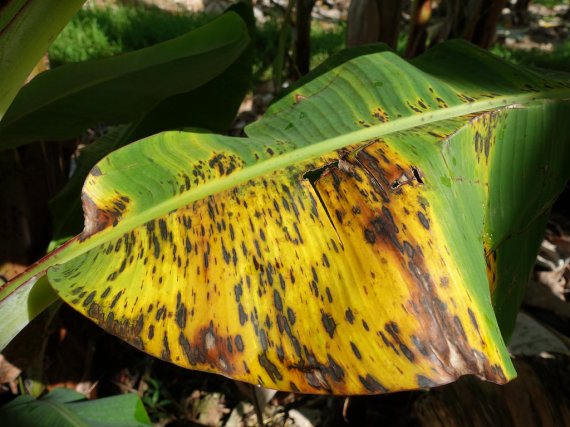The fungus Pseudocercospora fijiensis causes black sigatoka, a disease that affects the leaves of banana plants, causing banana harvests to be reduced or even lost entirely. The fungus is generally controlled using a group of fungicides, the azoles, but the fungus has been building up resistance to these biocides, and banana farmers need to spray increasingly often to keep the black sigatoka at bay. Pablo Chong, PhD candidate under phytopathologist Gert Kema, has been investigating which gene in the fungal DNA is the predominant point of engagement for these fungicides. His search pointed to the gene Pfcyp51.
Mechanism
Chong assessed no less than seven hundred variants of the fungus for resistance to three different azoles. Following this path, he was able to find out which mechanism was decreasing the fungus’ sensitivity to the fungicide. It is caused by an overexpression of Pfcyp51, causing the fungicide to be pumped around the fungus faster, which in turn brings about the drop in sensitivity.
As the gene is in the fungus, genetic modification of the plant would not make any difference. However, it does provide useful information to help find other biocides that would work on black sigatoka, says supervisor Kema. ‘It is important that we find agents with other points of application than the azoles to subdue the P. fijiensis fungus.’ A cocktail of agents would lead to a lessened evolutionary pressure by the fungicides, rendering the agents more effective. And this is necessary, as banana farmers currently spray fifty to seventy times a year to keep the black sigatoka at bay.
Resistant banana
But Kema fears that an alternative biocide is not a long-term solution either. ‘Sooner or later, the fungus will become resistant to the fungicide again. We should rather create a resistant banana. That is the basic solution. The Cavendish banana, which represents 95 percent of the global banana export, is extremely susceptible to P. fijiensis. We need to repair the Cavendish and create new varieties that taste better, last longer, produce more and are resistant to black sigatoka and other diseases.’ Then why is there no such variety yet? ‘Because the development would cost at least 20 million euros, and the banana sector is too conservative to invest that amount of money. Maybe we should do it ourselves.’ Chong’s research was funded by the government of Ecuador, the world’s largest banana exporter, and by the agrochemical company Syngenta.
Pablo Chong received his PhD on 31 October. His supervisor was Gert Kema, professor in Tropical Phytopathology.

